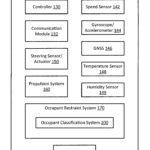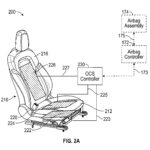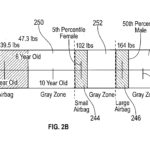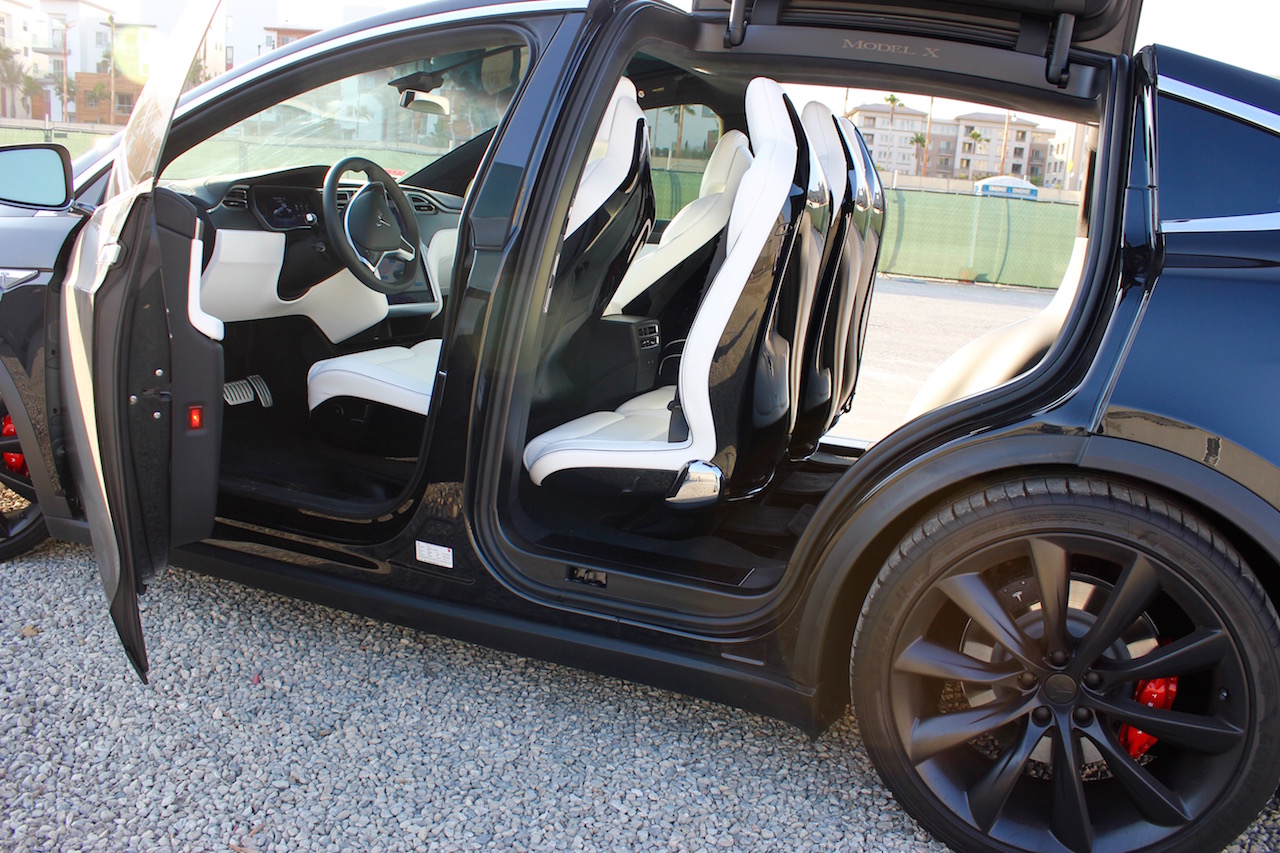
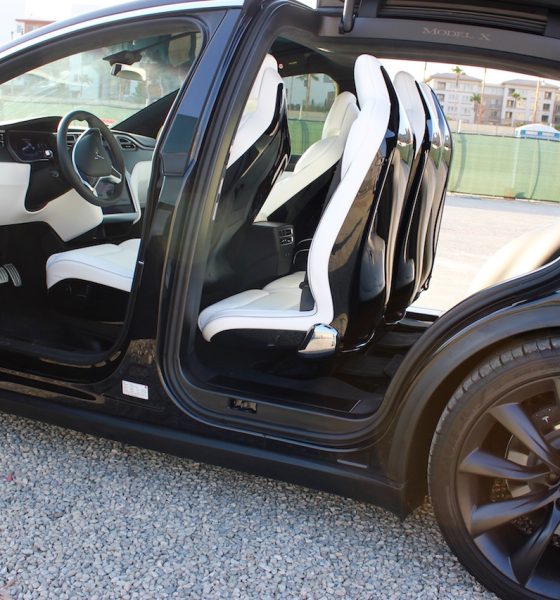
News
Tesla designs safer airbag deployment system through seat sensors in new patent
Tesla’s electric cars are among the safest on the road, so much so that the Model 3, Model S, and Model X are among the NHTSA’s top vehicles with the lowest probability of injury in the event of an accident. Thanks to Tesla’s use of ultra-high-strength steel and aluminum, as well as the vehicles’ extra large crumple zones due to their all-electric design, the company’s electric cars are capable of protecting their occupants when untoward events happen on the road.
If a recently published patent application is any indication, though, it appears that Tesla is exploring more ways to make its vehicles even safer. Tesla’s recent patent, titled “Sensors for Vehicle Occupant Classification Systems and Methods,” taps into the company’s prowess in tech by using a system that alows cars to detect and/or classify their occupants based on readings from a series of sensors in the seats. With such a system in place, safety features could activate in a way that is optimized for passengers.
- Diagrams depicting Tesla’s “Sensors for Vehicle Occupant Classification Systems and Methods” patent. (Credit: US Patent Office)
- Diagrams depicting Tesla’s “Sensors for Vehicle Occupant Classification Systems and Methods” patent. (Credit: US Patent Office)
- Diagrams depicting Tesla’s “Sensors for Vehicle Occupant Classification Systems and Methods” patent. (Credit: US Patent Office)
Diagrams depicting Tesla’s “Sensors for Vehicle Occupant Classification Systems and Methods” patent. (Credit: US Patent Office)
Tesla notes that cars on the road today are becoming safer overall, thanks to systems that monitor operations while the vehicle is in motion and features that provide coordinated alerts and assistance as needed. While such processes make vehicles safe, though, Tesla states that there is still a large area for improvement. One such area, according to the electric car maker, is in the way airbags deploy in the event of an accident.
“Difficulties remain in reliably detecting the presence of vehicle occupants and accurately classifying them as children, relatively small adults, and/or according to other classifications, and particularly in differentiating between classifications. Accurate classification can be critical when the vehicle is attempting to assist or enact safety measures to protect the occupant.
“In particular, airbag deployment can be adjusted to reduce risk of injury caused by the airbag while maintaining safety of the occupant during a collision. However, while reduced-force airbag deployment is recommended for relatively small adult females, it is not recommended for young children, even though the young children can reach heights and weights approaching those of the relatively small adult females. Thus, there is a need for an improved methodology to provide reliable and accurate vehicle occupant classification, particularly in the context of controlling an occupant restraint system that can apply force to an operator of the vehicle.”
Tesla’s patent application explores the use of sensors placed on the vehicle’s seats that enable the cars to classify their occupants. By classifying the size, weight, and body type (among others) of a passenger, the car would be able to deploy airbags in the safest way possible during an accident. Tesla describes this system as follows.
“In accordance with various embodiments of the present disclosure, occupant detection and classification may be provided by an occupant weight sensor, an occupant presence sensor, and a logic device configured to convert sensor signals provided by the occupant weight sensor and the occupant presence sensor into an estimated occupant weight and an occupant presence response, which may be used together to reliably detect and classify the occupant with increased sensitivity, accuracy, and granularity compared to conventional detection systems.
“In particular, embodiments of the present occupant classification system may be employed to detect and differentiate a child from a relatively small woman or man and disable, partially enable, or fully enable an airbag as appropriate. Such occupant classification systems may be implemented with various types of user feedback mechanisms, including reporting detections and classifications both locally and remotely, such as to a smartphone, for example, and reporting potentially unsafe conditions and/or undesired operation of the vehicle, as described herein.”
With this system in place, Tesla’s electric cars would be even safer than they already are. If any, this would widen the gap further between Tesla’s vehicles and conventional cars, many of which are bogged down in frontal collisions due to the presence of a large, heavy engine under the hood. That said, this recent patent application all but emphasizes Tesla’s proactive nature and the company’s tendency to always make efforts to improve.
This particular nature was emphasized by Elon Musk on Twitter last October, when he explained that there is “no such thing” as a “full refresh” or even a model year at Tesla. In his tweet, Musk stated that all the company’s vehicles are partially upgraded every month “as soon as a subsystem is ready for production,” thereby ensuring buyers that they are getting the best vehicles available at their time of purchase. This, coupled with Tesla’s trademark over-the-air updates — which give new features from driver assist functions such as Navigate on Autopilot, to fun, quirky things like the Romance Mode Easter Egg — truly make the company’s electric cars unique on the road.
The full text of Tesla’s recent patent application could be accessed here.

News
Nvidia CEO Jensen Huang explains difference between Tesla FSD and Alpamayo
“Tesla’s FSD stack is completely world-class,” the Nvidia CEO said.

NVIDIA CEO Jensen Huang has offered high praise for Tesla’s Full Self-Driving (FSD) system during a Q&A at CES 2026, calling it “world-class” and “state-of-the-art” in design, training, and performance.
More importantly, he also shared some insights about the key differences between FSD and Nvidia’s recently announced Alpamayo system.
Jensen Huang’s praise for Tesla FSD
Nvidia made headlines at CES following its announcement of Alpamayo, which uses artificial intelligence to accelerate the development of autonomous driving solutions. Due to its focus on AI, many started speculating that Alpamayo would be a direct rival to FSD. This was somewhat addressed by Elon Musk, who predicted that “they will find that it’s easy to get to 99% and then super hard to solve the long tail of the distribution.”
During his Q&A, Nvidia CEO Jensen Huang was asked about the difference between FSD and Alpamayo. His response was extensive:
“Tesla’s FSD stack is completely world-class. They’ve been working on it for quite some time. It’s world-class not only in the number of miles it’s accumulated, but in the way it’s designed, the way they do training, data collection, curation, synthetic data generation, and all of their simulation technologies.
“Of course, the latest generation is end-to-end Full Self-Driving—meaning it’s one large model trained end to end. And so… Elon’s AD system is, in every way, 100% state-of-the-art. I’m really quite impressed by the technology. I have it, and I drive it in our house, and it works incredibly well,” the Nvidia CEO said.
Nvidia’s platform approach vs Tesla’s integration
Huang also stated that Nvidia’s Alpamayo system was built around a fundamentally different philosophy from Tesla’s. Rather than developing self-driving cars itself, Nvidia supplies the full autonomous technology stack for other companies to use.
“Nvidia doesn’t build self-driving cars. We build the full stack so others can,” Huang said, explaining that Nvidia provides separate systems for training, simulation, and in-vehicle computing, all supported by shared software.
He added that customers can adopt as much or as little of the platform as they need, noting that Nvidia works across the industry, including with Tesla on training systems and companies like Waymo, XPeng, and Nuro on vehicle computing.
“So our system is really quite pervasive because we’re a technology platform provider. That’s the primary difference. There’s no question in our mind that, of the billion cars on the road today, in another 10 years’ time, hundreds of millions of them will have great autonomous capability. This is likely one of the largest, fastest-growing technology industries over the next decade.”
He also emphasized Nvidia’s open approach, saying the company open-sources its models and helps partners train their own systems. “We’re not a self-driving car company. We’re enabling the autonomous industry,” Huang said.
Elon Musk
Elon Musk confirms xAI’s purchase of five 380 MW natural gas turbines
The deal, which was confirmed by Musk on X, highlights xAI’s effort to aggressively scale its operations.

xAI, Elon Musk’s artificial intelligence startup, has purchased five additional 380 MW natural gas turbines from South Korea’s Doosan Enerbility to power its growing supercomputer clusters.
The deal, which was confirmed by Musk on X, highlights xAI’s effort to aggressively scale its operations.
xAI’s turbine deal details
News of xAI’s new turbines was shared on social media platform X, with user @SemiAnalysis_ stating that the turbines were produced by South Korea’s Doosan Enerbility. As noted in an Asian Business Daily report, Doosan Enerbility announced last October that it signed a contract to supply two 380 MW gas turbines for a major U.S. tech company. Doosan later noted in December that it secured an order for three more 380 MW gas turbines.
As per the X user, the gas turbines would power an additional 600,000+ GB200 NVL72 equivalent size cluster. This should make xAI’s facilities among the largest in the world. In a reply, Elon Musk confirmed that xAI did purchase the turbines. “True,” Musk wrote in a post on X.
xAI’s ambitions
Recent reports have indicated that xAI closed an upsized $20 billion Series E funding round, exceeding the initial $15 billion target to fuel rapid infrastructure scaling and AI product development. The funding, as per the AI startup, “will accelerate our world-leading infrastructure buildout, enable the rapid development and deployment of transformative AI products.”
The company also teased the rollout of its upcoming frontier AI model. “Looking ahead, Grok 5 is currently in training, and we are focused on launching innovative new consumer and enterprise products that harness the power of Grok, Colossus, and 𝕏 to transform how we live, work, and play,” xAI wrote in a post on its website.
Elon Musk
Elon Musk’s xAI closes upsized $20B Series E funding round
xAI announced the investment round in a post on its official website.

xAI has closed an upsized $20 billion Series E funding round, exceeding the initial $15 billion target to fuel rapid infrastructure scaling and AI product development.
xAI announced the investment round in a post on its official website.
A $20 billion Series E round
As noted by the artificial intelligence startup in its post, the Series E funding round attracted a diverse group of investors, including Valor Equity Partners, Stepstone Group, Fidelity Management & Research Company, Qatar Investment Authority, MGX, and Baron Capital Group, among others.
Strategic partners NVIDIA and Cisco Investments also continued support for building the world’s largest GPU clusters.
As xAI stated, “This financing will accelerate our world-leading infrastructure buildout, enable the rapid development and deployment of transformative AI products reaching billions of users, and fuel groundbreaking research advancing xAI’s core mission: Understanding the Universe.”
xAI’s core mission
Th Series E funding builds on xAI’s previous rounds, powering Grok advancements and massive compute expansions like the Memphis supercluster. The upsized demand reflects growing recognition of xAI’s potential in frontier AI.
xAI also highlighted several of its breakthroughs in 2025, from the buildout of Colossus I and II, which ended with over 1 million H100 GPU equivalents, and the rollout of the Grok 4 Series, Grok Voice, and Grok Imagine, among others. The company also confirmed that work is already underway to train the flagship large language model’s next iteration, Grok 5.
“Looking ahead, Grok 5 is currently in training, and we are focused on launching innovative new consumer and enterprise products that harness the power of Grok, Colossus, and 𝕏 to transform how we live, work, and play,” xAI wrote.
